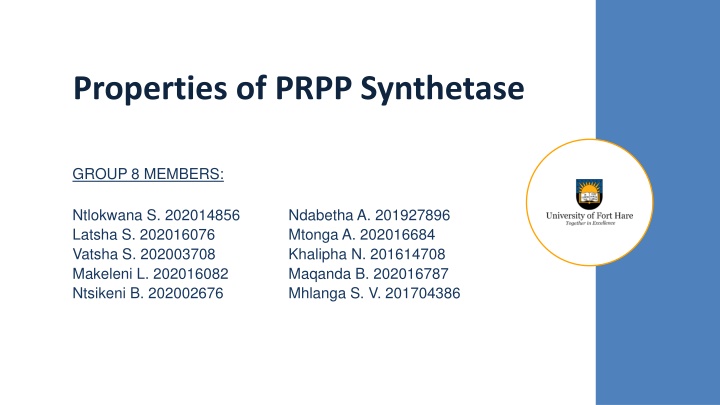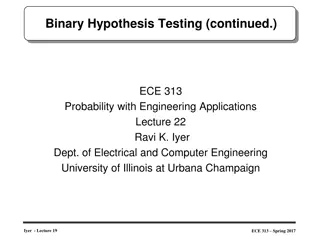
Properties of PRPP Synthetase and Functional Insights
Explore the properties of PRPP Synthetase including its group members, IEC number, primary sequence, 3D structure, isoforms in humans, enzyme class, and catalytic mechanism. Gain a comprehensive understanding of this essential enzyme involved in nucleotide biosynthesis.
Uploaded on | 4 Views
Download Presentation

Please find below an Image/Link to download the presentation.
The content on the website is provided AS IS for your information and personal use only. It may not be sold, licensed, or shared on other websites without obtaining consent from the author. If you encounter any issues during the download, it is possible that the publisher has removed the file from their server.
You are allowed to download the files provided on this website for personal or commercial use, subject to the condition that they are used lawfully. All files are the property of their respective owners.
The content on the website is provided AS IS for your information and personal use only. It may not be sold, licensed, or shared on other websites without obtaining consent from the author.
E N D
Presentation Transcript
Properties of PRPP Synthetase GROUP 8 MEMBERS: Ntlokwana S. 202014856 Latsha S. 202016076 Vatsha S. 202003708 Makeleni L. 202016082 Ntsikeni B. 202002676 Ndabetha A. 201927896 Mtonga A. 202016684 Khalipha N. 201614708 Maqanda B. 202016787 Mhlanga S. V. 201704386
IEC number The IEC number of PRPP synthetase is 2.7.6.1.
PRIMARY SEQUENCE For class I of PRPP synthetase, the primary sequence contains two human PRPP synthetase subunits forming a homodimer, six SO4 2 ions and 183 water molecules in the asymmetric unit. Subunit A contains 305 amino acid residues from Asparagine to Phenylalanine except for Lysine to Valine, and subunit B contains 308 amino acid residues from Asparagine to Proline except for Arginine to Valine (Li et al., 2006).
Functional 3D structure There synthetase subunits (coloured in green and yellow respectively) asymmetric unit forming a homodimer (Li et al., 2006). The flexible loop involved in ATP binding is shown in blue, the PPi binding loop in magenta, the R5P binding loop in cyan and the flag region in red (for clarity, only one subunit is colour-coded). are two human PRPP in an Figure 1: Structure of Human PRPP synthetase.
Human PRPP synthetases (hPRS1) have three isoforms that share very high sequence identity (95.0% between hPRS1 and hPRS2; 94.3% between hPRS1 and hPRS3; and 91.2% between hPRS2 and hPRS3 respectively) (Li et al., 2006). Characteristics of its functional 3D structure Human PRPP synthetase 1 and hPRS2 genes are located on the X chromosome and are expressed in a wide range of tissues, but hPRS3 is an autosomal gene expressed specifically in testis (Li et al., 2006). Human PRPP synthetase 1 contains 318 amino acids and shares a moderate sequence identity with bacillus PRPP synthetase (bsPRS) (47% identity and 67% similarity respectively). It requires phosphate for activation and uses Mg2+ for activity (Li et al., 2006).
PDB FILE PDB ID: 3 LRT
ENZYME CLASS PRPP synthetase belongs to a class of enzymes that catalyse the transfer of specific functional groups from one molecule to another. This enzyme class is known as transferases (Becker, 2002).
When observing the reaction below, the pyrophosphate group of ATP is transferred into ribose 5-phosphate, the product PRPP is a high-energy compound. PRPP synthetase has a soluble requirement for inorganic phosphate, which functions as an allosteric activator. The enzyme is inhibited by many nucleotides, of which are the product of the pathway for which PRPP is an essential substrate (Hove-Jensen et al., 2017). REACTION MECHANISM Figure 2: The reaction mechanism of PRPP synthetase.
PATHWAY Pentose phosphate pathway Purine metabolism Metabolic pathways Biosynthesis of secondary metabolites Microbial metabolism environments in diverse Figure 3: Pentose phosphate pathway.
LOCATION OF CELL It is located in the X-chromosomes.
REFERENCES Becker, M.A. and Ahmed, M., 2002. Cell type-specific differential expression of human PRPP synthetase (PRPS) genes. Purine and Pyrimidine Metabolism in Man X, pp.5-10. Hove-Jensen, B., Andersen, K. R., Kilstrup, M., Martinussen, J., Switzer, R. L. and Willemo s, M., 2017. Phosphoribosyl diphosphate (PRPP): biosynthesis, enzymology, utilization, and metabolic significance. Microbiology and Molecular Biology Reviews, 81(1), pp.40-16. Iizasa, T., 2008. Increased activity of PRPP synthetase. Nihon rinsho. Japanese journal of clinical medicine, 66(4), pp.694-698. Li, S., Lu, Y., Peng, B. and Ding, J., 2006. Crystal structure of human phosphoribosylpyrophosphate synthetase 1 reveals a novel allosteric site. Biochemical Journal, 401(1), pp.39-47.













![BCH 462- Biotechnology & Genetic engineering [Practical]](/thumb/273367/bch-462-biotechnology-genetic-engineering-practical.jpg)

